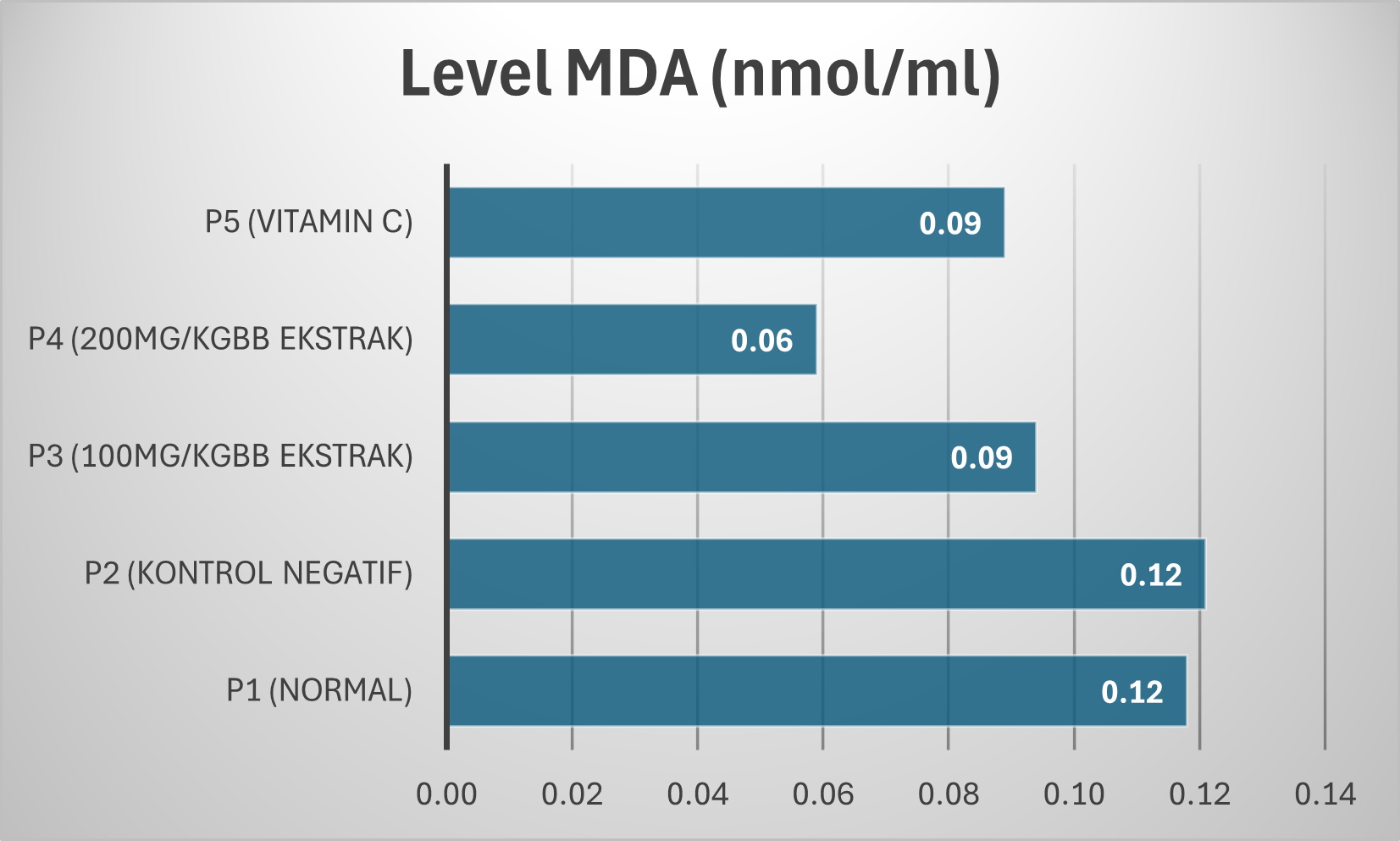Pengaruh Pemberian Ekstrak Kunyit Putih (Curcuma zedoaria Rosc.) terhadap Kadar Malondialdehid (MDA) Tikus Putih (Rattus norvegicus) yang Terpapar Asap Rokok
DOI:
https://doi.org/10.36733/medicamento.v11i1.10793Kata Kunci:
antioksidan, kunyit putih (Curcuma zedoaria Rosc), malondialdehid (MDA)Abstrak
Asap rokok menghasilkan radikal bebas yang menyebabkan stres oksidatif dan kerusakan berbagai biomolekul tubuh. Peningkatan kadar malondialdehid (MDA) merupakan salah satu penanda terjadinya stres oksidatif. Mekanisme pertahanan tubuh terhadap stres oksidatif melibatkan senyawa antioksidan. Kunyit putih (Curcuma zedoaria Rosc.) mengandung senyawa antioksidan yang diprediksi mampu menghambat kerusakan oksidatif, namun potensinya secara in vivo masih perlu dibuktikan. Penelitian ini bertujuan untuk mengevaluasi pengaruh ekstrak etanol kunyit putih terhadap kadar MDA pada tikus putih jantan (Rattus novergicus strain Wistar) yang dipaparkan asap rokok. Desain penelitian yang digunakan adalah post-test only control group. Lima kelompok perlakuan terdiri atas kelompok kontrol sehat (P1), kelompok kontrol yang dipaparkan asap rokok tanpa perlakuan (P2), kelompok perlakuan ekstrak kunyit putih dosis 100 mg/kgBB (P3), 200 mg/kgBB (P4), dan kelompok kontrol positif yang diberikan vitamin C (P5). Paparan asap rokok diberikan selama 14 hari, kemudian darah diambil dari vena orbita pada hari ke-15 untuk pengukuran kadar MDA dengan metode ELISA. Rerata kadar MDA (mmol/ml) masing-masing kelompok adalah: 0,118 (P1), 0,121 (P2), 0,094 (P3), 0,059 (P4), dan 0,089 (P5). Hasil analisis ANOVA dan uji post hoc LSD (α = 0,05) menunjukkan perbedaan signifikan antara kelompok P2 dan P4 (p < 0,05), namun tidak terdapat perbedaan bermakna antara kelompok P3, P4, dan P5. Pemberian ekstrak kunyit putih dosis 200 mg/kgBB menurunkan kadar MDA secara signifikan dan menunjukkan aktivitas antioksidan yang sebanding dengan vitamin C.
Referensi
Istiqomah U. Upaya Menuju Generasi Tanpa Merokok Pendekatan Analisis Untuk Menangulangi Dan Mengantisipasi Remaja Merokok. Surakarta: CV. Setia Aji.; 2003.
Rupinder K. Environmental Tobacco Smoke (ETS)-A Silent Killer. Int J Life Sci. 2014;2(2):179–184. www.ijlsci.in
Wolrd Health Organization (WHO). WHO Reports On The Global Tobacco Epidemic. Sci Am. 2013;272(5):44–51. doi:10.1038/scientificamerican0595-44
Emma R, Caruso M, Campagna D, Pulvirenti R, Li Volti G. The Impact of Tobacco Cigarettes, Vaping Products and Tobacco Heating Products on Oxidative Stress. Antioxidants. 2022;11(9):1–28. doi:10.3390/antiox11091829
Ayala A, Muñoz MF, Argüelles S. Lipid Peroxidation: Production, Metabolism, and Signaling Mechanisms Of Malondialdehyde and 4-hydroxy-2-nonenal. Oxid Med Cell Longev. 2014;2014. doi:10.1155/2014/360438
Marliani L, Budiana W, Anandari Y. The Effect of Extraction Condition on The Polyphenol Content and Antioxidant Activity of Curcuma Zedoaria (Christm.) Roscoe Rhizome. Indones J Pharm Sci Technol. 2017;4(2):57. doi:10.15416/ijpst.v4i2.12770
Lobo R, Prabhu KS, Shirwaikar A, Shirwaikar A. Curcuma Zedoaria Rosc. (White Turmeric): A Review Of Its Chemical, Pharmacological and Ethnomedicinal Properties. J Pharm Pharmacol. 2008;61(1):13–21. doi:10.1211/jpp/61.01.0003
Gharge S, Hiremath SI, Kagawad P, Jivaje K, Palled MS, Suryawanshi SS. Curcuma Zedoaria Rosc (Zingiberaceae): A Review On Its Chemical, Pharmacological and Biological Activities. Futur J Pharm Sci. 2021;7(1):1–9. doi:10.1186/s43094-021-00316-1
Kurutas EB. The Importance of Antioxidants Which Play the Role in Cellular Response Against Oxidative/Nitrosative Stress: Current State. Nutr J. 2016;15(1):1–22. doi:10.1186/s12937-016-0186-5
Ranjitha A, Asif K, Himaja M. Phytochemical Screening and Antioxidant Activity of Rhizome Part of Curcuma Zedoaria. Int J Res Ayurveda Pharm. 2010;1(2):414–417.
Pujimulyani D. Sifat Antioksidatif Ekstrak Kunir Putih (Curcuma mangga Val.) dengan Pelarut Aseton, Etanol atau Metanol. Biota J Ilm Ilmu-Ilmu Hayati. 2019;XI(1):14–19. doi:10.24002/biota.v11i1.2817
Pizzino G, Irrera N, Cucinotta M, et al. Oxidative Stress: Harms and Benefits for Human Health. Oxid Med Cell Longev. 2017;2017. doi:10.1155/2017/8416763
Isik B, Ceylan A, Isik R. Oxidative Stress In Smokers and Non-Smokers. Inhal Toxicol. 2007;19(9):767–769. doi:10.1080/08958370701401418
Hu JP, Zhao XP, Ma XZ, Wang Y, Zheng LJ. Effects Of Cigarette Smoke On Aerobic Capacity and Serum MDA Content and SOD Activity Of Animal. Int J Clin Exp Med. 2014;7(11):4461–4465.
Tariq S, Imran M, Mushtaq Z, Asghar N. Phytopreventive Antihypercholesterolmic and Antilipidemic Perspectives Of Zedoary (Curcuma Zedoaria Roscoe.) Herbal Tea. Lipids Health Dis. 2016;15(1):1–10. doi:10.1186/s12944-016-0210-y
Mahmoudi T, Lorigooini Z, Rafieian-Kopaei M, et al. Effect Of Curcuma Zedoaria Hydro-Alcoholic Extract On Learning, Memory Deficits and Oxidative Damage Of Brain Tissue Following Seizures Induced By Pentylenetetrazole In Rat. Behav Brain Funct. 2020;16(1):1–12. doi:10.1186/s12993-020-00169-3
Hussain T, Tan B, Yin Y, Blachier F, Tossou MCB, Rahu N. Oxidative Stress and Inflammation: What Polyphenols Can Do for Us? Oxid Med Cell Longev. 2016;2016. doi:10.1155/2016/7432797
Katiyar D, Singh V, Ali M. Isolation, Characterization and Prediction of Biological Activity of Two New Fatty Esters and a Phenol From the Heartwood of Pterocarpus Marsupium Roxb. Int J Pharm Pharm Sci. 2017;9(2):117. doi:10.22159/ijpps.2017v9i2.15938
Bosch R, Philips N, Suárez-Pérez JA, et al. Mechanisms Of Photoaging and Cutaneous Photocarcinogenesis, and Photoprotective Strategies With Phytochemicals. Antioxidants. 2015;4(2):248–268. doi:10.3390/antiox4020248
Heim KE, Tagliaferro AR, Bobilya DJ. Flavonoid Antioxidants: Chemistry, Metabolism and Structure-Activity Relationships. J Nutr Biochem. 2002;13(10):572–584. doi:10.1016/S0955-2863(02)00208-5
Mishra A, Kumar S, Pandey AK. Scientific Validation Of The Medicinal Efficacy Of Tinospora Cordifolia. Sci World J. 2013;2013. doi:10.1155/2013/292934
Kumar S, Sharma AK, Sharma P, AK. Protective Efficacy Of Solanum Xanthocarpum Root Extracts Against Free Radical Damage Phytochemical Analysis and Antioxidant Effect. Cell and Molecular Biol. 2012;58(1):174–81..
Oteiza PI, Erlejman AG, Verstraeten S V., Keen CL, Fraga CG. Flavonoid-membrane interactions: A protective role of flavonoids at the membrane surface? Clin Dev Immunol. 2005;12(1):19–25. doi:10.1080/10446670410001722168
Nijveldt RJ, Van Nood E, Van Hoorn DEC, Boelens PG, Van Norren K, Van Leeuwen PAM. Flavonoids: A Review Of Probable Mechanisms Of Action and Potential Applications. Am J Clin Nutr. 2001;74(4):418–425. doi:10.1093/ajcn/74.4.418

Unduhan
Telah diserahkan
Diterima
Diterbitkan
Cara Mengutip
Terbitan
Bagian
Lisensi
Hak Cipta (c) 2025 I Made Agus Sunadi Putra, I Putu Tangkas Suwantara, Maria Malida Vernandes Sasadara, Ni Nyoman Wahyu Udayani

Artikel ini berlisensi Creative Commons Attribution-NonCommercial-NoDerivatives 4.0 International License.

















